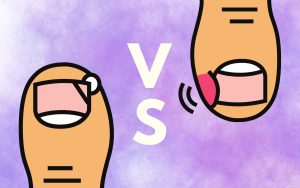Ingrown nails can be a painful and bothersome condition that affects many individuals. Whether you’ve experienced it firsthand or know someone who has, understanding the different stages of ingrown nails is essential for effective treatment and prevention.

In this blog post, we’ll delve into the various stages of ingrown nails, exploring their causes, symptoms, and potential complications. By gaining a comprehensive understanding of these stages, you’ll be better equipped to identify the problem early on and seek appropriate care.
Recognizing the Early Signs of Ingrown Nails
Ingrown nails can often be identified in their early stages if you know what to look for. By recognizing the early signs, you can take prompt action and prevent the condition from worsening. Here are some key indicators to watch out for:
Nail Tenderness and Discomfort
One of the initial signs of an ingrown nail is tenderness and discomfort around the affected nail. You may notice a mild throbbing or aching sensation that is localized to the area. This discomfort is often more pronounced when pressure is applied to the nail or when wearing tight-fitting shoes.
Redness and Swelling Around the Nail Bed
Another early indication of an ingrown nail is redness and swelling around the nail bed. The skin surrounding the affected nail may appear inflamed, with a pink or reddish hue. The swelling can make the area feel tender and sensitive to touch.
Read This Next:
Formation of a Small, Tender Bump
As the ingrown nail progresses, a small, tender bump may develop near the edge of the nail. This bump is usually filled with fluid and can be sensitive to pressure. It may appear slightly raised and have a reddish or whitish color. The bump may cause discomfort and make it challenging to wear shoes comfortably.
Recognizing the Early Signs of Ingrown Nails
Ingrown nails can often be identified in their early stages if you know what to look for. By recognizing the early signs, you can take prompt action and prevent the condition from worsening. Here are some key indicators to watch out for:
Nail Tenderness and Discomfort
One of the initial signs of an ingrown nail is tenderness and discomfort around the affected nail. You may notice a mild throbbing or aching sensation that is localized to the area. This discomfort is often more pronounced when pressure is applied to the nail or when wearing tight-fitting shoes.
Redness and Swelling Around the Nail Bed
Another early indication of an ingrown nail is redness and swelling around the nail bed. The skin surrounding the affected nail may appear inflamed, with a pink or reddish hue. The swelling can make the area feel tender and sensitive to touch.
Formation of a Small, Tender Bump
As the ingrown nail progresses, a small, tender bump may develop near the edge of the nail. This bump is usually filled with fluid and can be sensitive to pressure. It may appear slightly raised and have a reddish or whitish color. The bump may cause discomfort and make it challenging to wear shoes comfortably.
Advanced Stages and Complications of Ingrown Nails
When ingrown nails reach advanced stages, they can cause significant pain and discomfort, as well as lead to potential complications. It’s crucial to be aware of these advanced stages and their associated complications to understand the importance of seeking professional medical help. Let’s explore the advanced stages of ingrown nails and the potential complications that may arise if the condition remains unaddressed.
Intense Pain and Throbbing
In the advanced stages of ingrown nails, the pain and throbbing sensations can become excruciating. Every step you take or any pressure applied to the affected area may elicit intense discomfort. The pain can be constant, making it challenging to perform regular activities and negatively impacting your overall well-being.
Open Sores or Ulcers
If an ingrown nail continues to worsen without treatment, open sores or ulcers may develop around the affected nail. These sores can be painful, prone to infection, and slow to heal. They can further increase the risk of complications and require more extensive treatment measures.
Difficulty Walking or Performing Daily Activities
With advanced stages of ingrown nails, the pain and discomfort can significantly impair your ability to walk or engage in everyday activities. The simple act of putting on shoes or walking barefoot can become a daunting task. This limitation can have a significant impact on your mobility and overall quality of life.
Risk of Cellulitis and Bone Infection
Untreated ingrown nails can lead to severe complications such as cellulitis, a bacterial skin infection, and bone infection (osteomyelitis). These infections can spread beyond the nail area, affecting the surrounding tissues and potentially reaching the bone. Both conditions require immediate medical attention and may necessitate more aggressive treatment approaches.
Treatment Options for Ingrown Nails at Each Stage
Addressing ingrown nails promptly and effectively requires appropriate treatment options tailored to the specific stage of the condition. Let’s explore the different treatment options available at each stage of ingrown nails, emphasizing the importance of early intervention and proper care.
Mild and Early-Stage Treatments
Soaking the Affected Area in Warm Water
Soaking the affected foot or hand in warm water can help reduce inflammation and relieve discomfort associated with mild ingrown nails. Add Epsom salt or a mild antiseptic solution to the water for additional soothing effects. Soak for 15-20 minutes, two to three times a day, to help soften the nail and ease the pressure on the surrounding skin.
Applying Topical Antibiotics or Antiseptics
After soaking, applying a topical antibiotic or antiseptic ointment can help prevent infection and promote healing. These over-the-counter creams or ointments can be applied directly to the affected area as per the instructions provided. They can help keep the area clean and reduce the risk of bacterial growth.
Wearing Open-Toed Shoes or Sandals
To alleviate pressure on the affected nail, opt for open-toed shoes or sandals that provide ample space for your toes. This helps reduce friction and allows for better air circulation, promoting faster healing and minimizing discomfort. Avoid wearing tight or constrictive footwear that puts additional pressure on the ingrown nail.
Intermediate and Severe-Stage Treatments
Professional Nail Trimming or Removal
In intermediate and severe stages of ingrown nails, seeking professional help from a podiatrist or a healthcare provider is advisable. They can carefully trim or remove the ingrown portion of the nail, relieving pain and preventing further progression. This procedure is usually performed under sterile conditions to minimize the risk of infection.
Oral Antibiotics for Infections
If an infection is present, your healthcare provider may prescribe oral antibiotics to help combat the infection and prevent it from spreading. It’s essential to take the prescribed antibiotics as directed and complete the full course of medication to ensure effective treatment.
Surgical Intervention (Partial Nail Avulsion)
In severe cases or recurrent ingrown nails, surgical intervention may be necessary. Partial nail avulsion is a procedure where a portion of the ingrown nail is permanently removed to prevent further recurrence. This is typically done under local anesthesia and is considered a safe and effective treatment option.
Conclusion
In conclusion, understanding the different stages of ingrown nails is vital for managing this common condition. By recognizing the early signs and symptoms, you can take prompt action to prevent further progression and complications. Whether it’s practicing proper nail care techniques, wearing appropriate footwear, or seeking professional help when necessary, there are various preventive measures and treatment options available.









